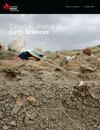Petrogenesis and tectonic significance of the Early Cretaceous Xizhelimu diorite in Keyouzhongqi, Inner Mongolia, China
IF 1.6
4区 地球科学
Q3 GEOSCIENCES, MULTIDISCIPLINARY
引用次数: 0
Abstract
In order to determine the emplacement age, petrogenesis and geodynamic setting of the Xizhelimu diorite in Keyouzhongqi, Inner Mongolia of northeastern China, a detailed study of the petrography, geochronology and whole-rock geochemistry has been conducted. Geological and petrographic studies show that the Xizhelimu diorite is zoned: the central lithofacies zone is composed of medium-fine-grained monzodiorite and quartz diorite, and the marginal lithofacies zone is fine-grained diorite. The zircon U-Pb dating results show that the ages of the central and marginal facies are 133.5 ± 1.9 Ma and 133.4 ± 1.4 Ma, respectively. The whole-rock rare earth and trace element characteristics of the Xizhelimu diorite show an O-type adakite affinity. Combining the analysis of zircon Hf isotope composition (εHf(t) values of +7.7 to +10.0), the geochemical features of whole rock, and the results of partial melting modeling we suggest that the parental magma of the Xizhelimu diorite was derived from the partial melting of altered oceanic crust mixing with subducting sediments at shallow depths. In the early stage of Early Cretaceous, the Xizhelimu diorite originated in an extensional setting, mainly related to the closure of the western part of the Mongol–Okhotsk Ocean. The upwelling asthenospheric flow in this extensional setting induced partial melting of the paleo-oceanic crust to form the parental magma of the Xizhelimu diorite.内蒙古可游中旗早白垩世喜直里木闪长岩成因及构造意义
为确定内蒙古克酉中旗喜直里木闪长岩的侵位时代、岩石成因和地球动力学背景,对其岩石学、年代学和全岩地球化学进行了详细的研究。地质岩相学研究表明,喜直里木闪长岩具有分带性:中部岩相带为中细粒二黄长岩和石英闪长岩,边缘岩相带为细粒闪长岩。锆石U-Pb定年结果表明,中、边缘相年龄分别为133.5±1.9 Ma和133.4±1.4 Ma。西柘木闪长岩全岩稀土及微量元素特征表现为o型埃达奇岩亲和。结合锆石Hf同位素组成分析(εHf(t)值为+7.7 ~ +10.0)、全岩地球化学特征及部分熔融模拟结果,认为喜直里木闪长岩母岩浆来源于蚀变洋壳与浅部俯冲沉积物的部分熔融混合作用。早白垩世早期,喜泽里木闪长岩形成于拉张环境,主要与蒙古-鄂霍次克洋西部的闭合有关。伸展背景下的软流上涌导致古洋壳部分熔融,形成了西柘木闪长岩的母岩浆。
本文章由计算机程序翻译,如有差异,请以英文原文为准。
求助全文
约1分钟内获得全文
求助全文
来源期刊

Canadian Journal of Earth Sciences
地学-地球科学综合
CiteScore
2.80
自引率
7.10%
发文量
66
审稿时长
6-12 weeks
期刊介绍:
The Canadian Journal of Earth Sciences reports current research in climate and environmental geoscience; geoarchaeology and forensic geoscience; geochronology and geochemistry; geophysics; GIS and geomatics; hydrology; mineralogy and petrology; mining and engineering geology; ore deposits and economic geology; paleontology, petroleum geology and basin analysis; physical geography and Quaternary geoscience; planetary geoscience; sedimentology and stratigraphy; soil sciences; and structural geology and tectonics. It also publishes special issues that focus on information and studies about a particular segment of earth sciences.
 求助内容:
求助内容: 应助结果提醒方式:
应助结果提醒方式:


